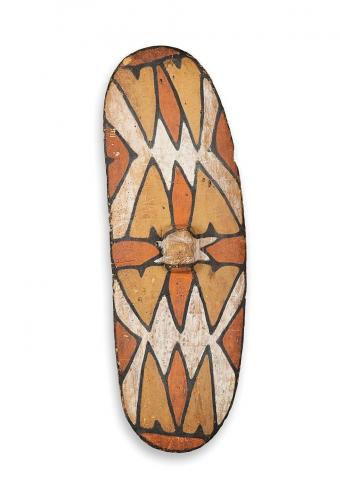late 19th / early 20th century
A RAINFOREST SHIELD
carved from the buttress root of a Fig Tree, of elongated ovoid form, the front with raised boss decorated with traditional motifs in red, white and yellow earth pigments outlined in black, the reverse undecorated with lug handle embedded with hand forged nails and traces of pigment on the reverse
101.0 cm height
Private collection, Sydney
Shields, Herbert River, North Queensland, c1885, Fig tree wood, ochres, collection of the Macleay Museum, University of Sydney, illus. in Davies, S., Collected: 150 Years of Aboriginal Art and Artifacts at the Macleay Museum, Macleay Museum, Sydney, 2002, p. 76, pl. 85
The designs on shields such as this are associated with clan totems and are thought to possess protective qualities when used in battle with large single-handed sword clubs. The shields also played an important role in the initiation ceremonies of young men. This particular example shows evidence of extensive cultural use. Shields of this type were used to deflect spears, clubs and boomerangs during large gatherings of Aboriginal people, where disputes between individuals and groups were settled.1 It is also noted that the designs applied to the front surface of such shields differed, suggesting that they constituted an individual's 'coat of arms'.
1. Lumholtz, C., in Davies, S., Collected: 150 Years of Aboriginal Art and Artifacts at the Macleay Museum, University of Sydney, 2002, p. 76
